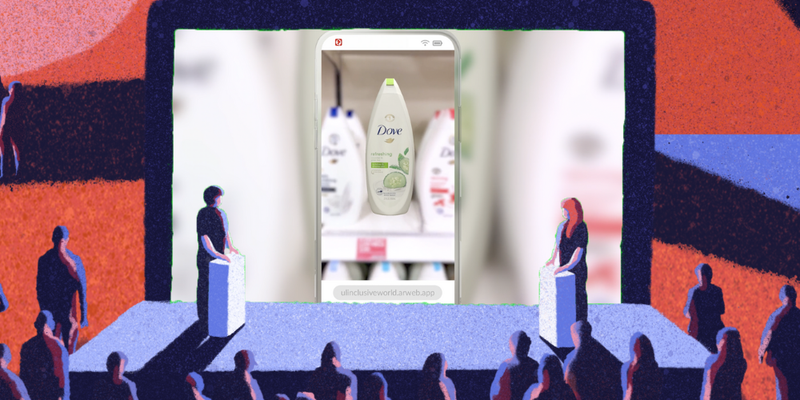As part of our AR Pioneers line up we were joined by our AR partners at Unilever, Sarah Masters (Digital Transformation Director) and Mark Hewitt (Brand and Digital Transformation) to talk about not only our latest initiative, Zapvision but also their connected packaging journey.
Sarah is responsible for looking after all things digital for the home care division of Unilever, everything from websites to digitizing packaging. Mark works helping to set up and deploy connected packaging across all the business groups around the world for Unilever. With these two minds in the AR Pioneers hotseat we found the opportunity to learn more about setting up a successful connected packaging strategy that was too hard to pass up.
We have taken some of the incredible insights they had to offer and created a step by step plan for getting started with a connected pack.
If you’d like to hear the full session and find out more about Zapvision and our partnership with Unilever it’s available to watch here.
Step One: Understanding the value of Connected Packaging
Connected packaging is still a relatively new concept, and as Sarah pointed out, up until a couple of years ago “businesses were yet to be convinced as to what it would mean for a consumer goods company.” However after a few brave souls went out to do some experimenting the results started rolling in, and to everyone’s surprise it seemed “consumers would actually engage with packaging in a digital way,” and this piqued Unliever’s interest.
“So we started to scope this space a bit and started to identify that our consumer goods packaging is probably the number one engagement platform for consumers with our brands. So the billions of consumer and brand moments that we have on a daily basis globally is what powers our brand.” - Sarah Masters
The next question was “How can we use the packaging as a springboard into the Unilever world, into our communications?”
This was where Mark came on board along with all of his expertise and together they identified that answer: QR codes.
QR codes are universally recognisable and a gateway to a wide variety of consumer content. In their most basic form they provide a portal to a website, ‘scan here and find out more’, however Unilever quickly identified that there could actually “be a much more powerful play” provided you know what you want to say.
Step Two: Identifying your purpose
Next comes the question: what is the purpose of your connected packing? As a brand you now have a way to speak directly to your consumers at the point of purchase and beyond, how do you make the most of that?
For a consumer goods company like Unilever, the benefits of having a “springboard into a digital ecosystem” could be applied to a variety of different areas.
“What does this mean for things like new products that consumers haven't used, experienced and held before? What does it mean for brand purpose and sustainability messaging? What does it mean if we want to drive repurchases?” - Sarah Masters
Each of these require very different, specific content and messaging to provide a benefit to both the brand and the consumer, so it's important that for each campaign you identify what you are trying to achieve.
Whatever your campaign, however, Unilever learnt that “there has to be a value exchange, for both us as a business and for consumers.” If the only call to action or incentive you provide is ‘click here to find out more’, “no one's going to do it, we've seen now in our numbers, in the stats, that no one clicks on that kind of call to action.”
“So we've put a lot of work into identifying what are the call to actions, what are the reasons for someone to engage in our packaging and drive a deeper level of engagement. So that's probably the crux of what we've been trying to figure out.” - Sarah Masters
Unilever found that the value exchange and call to action might be different for home care versus beauty versus foods, as they all have slightly different user journeys. So as home care, Sarah and Mark have been focused on that particular consumer journey. Once they found it, and once they'd done that initial research and optimization, it was time to scale.
Step Three: Time to set up and scale
Now you’ve got a plan in place, it's time to start executing and actioning it. For Unilever that is very much where Mark and his experience came in.
“There has to be a business case that everybody and senior managers can sign off on and understand. There's got to be tracking in place to understand if you've got good or bad performance.” - Mark Hewitt
For Unilever, getting the different brands on board and behind that business case meant “having a program where we could share everything on an ongoing basis, good and bad and have points of view about how all of that is optimized over time.” And executing the plan meant understanding the end-to-end process and all the different elements and functions within a business like Unilever “from artwork and design at one end, through to the tech teams, digital teams, and data teams,” so they could speak to each team in their own language and knit the project together. Once you’ve got these two elements in place it's all about sustaining that and repeating again and again on an ongoing basis, “and that's when you start to get to some scale.”
Something which Unilever has done very successfully; by the end of the year they will have 78 brands within Unilever as part of the program and will be at billions of packs across 120 markets.
When it comes to scaling, there are two different approaches, or speeds. Quick or slow. For Unilever there was a real debate internally: “do you go quickly and get scale because the faster you can get scale, you can get business buy-in and you start to build momentum and a wave of opportunity.” Or do you “go slow and have some pilots and try to get it right.”
For their connected packaging strategy Unilever went with the slow and steady approach because a huge project like this across packaging, actually impacts those products for years to come, “you can't just whip off a QR code a month later. If we started poorly, I don’t know if there was going to be a way to bring the project back.”
So what they did was test, "not only A/B testing but “B C D E testing”. Looking at more tactical approaches, trialing things like neck hangers and stickers which can be removed or promotional packaging with a shorter shelf life.
Step Four: Measuring your success
What are you looking for? What is your business looking for in terms of KPIs around your connected packaging? When it comes to engagement, clearly things like scan rates number one. What Unilever did was the analysis beneath that.
“If people are scanning. What kind of data collection are we gathering there? What can be improved through retargeting? What kind of improved media engagement rates can we get through this kind of subsequent media? Using that first party data is more effective than just buying second party or third party audiences in our media channels.” - Sarah Masters
Some of these metrics are really easy to track. Some of them are easy to track but hard to put value against and some of them are just quite hard to track. But at a base level, scan rates and driving engagement into a digital ecosystem is possible if you give consumers the right value exchange, make their life easy and give them entertainment or drive value.
Final Thoughts
So what can we take away from all this?
First of all, the value of connected packaging. It is the number one engagement channel you have for interacting with your consumers and with a simple QR code you can turn it into your best owned media channel.
Secondly, to achieve the results you want, you need to think clearly about your purpose and your call to action. Gone are the days when ‘scan here to find out more’ was incentive enough.
Thirdly, make sure you think about your approach, achieving buy-in and getting your teams on board is vital. Choosing how fast you scale can be make or break.
Finally, know what success looks like and what benefits these results are providing your business.
 Grace Vassallo
Grace VassalloSenior Brand & Marketing Manager, Zappar
